Song Guo
DiEP: Adaptive Mixture-of-Experts Compression through Differentiable Expert Pruning
Sep 19, 2025Abstract:Despite the significant breakthrough of Mixture-of-Experts (MoE), the increasing scale of these MoE models presents huge memory and storage challenges. Existing MoE pruning methods, which involve reducing parameter size with a uniform sparsity across all layers, often lead to suboptimal outcomes and performance degradation due to varying expert redundancy in different MoE layers. To address this, we propose a non-uniform pruning strategy, dubbed \textbf{Di}fferentiable \textbf{E}xpert \textbf{P}runing (\textbf{DiEP}), which adaptively adjusts pruning rates at the layer level while jointly learning inter-layer importance, effectively capturing the varying redundancy across different MoE layers. By transforming the global discrete search space into a continuous one, our method handles exponentially growing non-uniform expert combinations, enabling adaptive gradient-based pruning. Extensive experiments on five advanced MoE models demonstrate the efficacy of our method across various NLP tasks. Notably, \textbf{DiEP} retains around 92\% of original performance on Mixtral 8$\times$7B with only half the experts, outperforming other pruning methods by up to 7.1\% on the challenging MMLU dataset.
Efficient Edge LLMs Deployment via HessianAware Quantization and CPU GPU Collaborative
Aug 10, 2025Abstract:With the breakthrough progress of large language models (LLMs) in natural language processing and multimodal tasks, efficiently deploying them on resource-constrained edge devices has become a critical challenge. The Mixture of Experts (MoE) architecture enhances model capacity through sparse activation, but faces two major difficulties in practical deployment: (1) The presence of numerous outliers in activation distributions leads to severe degradation in quantization accuracy for both activations and weights, significantly impairing inference performance; (2) Under limited memory, efficient offloading and collaborative inference of expert modules struggle to balance latency and throughput. To address these issues, this paper proposes an efficient MoE edge deployment scheme based on Hessian-Aware Quantization (HAQ) and CPU-GPU collaborative inference. First, by introducing smoothed Hessian matrix quantization, we achieve joint 8-bit quantization of activations and weights, which significantly alleviates the accuracy loss caused by outliers while ensuring efficient implementation on mainstream hardware. Second, we design an expert-level collaborative offloading and inference mechanism, which, combined with expert activation path statistics, enables efficient deployment and scheduling of expert modules between CPU and GPU, greatly reducing memory footprint and inference latency. Extensive experiments validate the effectiveness of our method on mainstream large models such as the OPT series and Mixtral 8*7B: on datasets like Wikitext2 and C4, the inference accuracy of the low-bit quantized model approaches that of the full-precision model, while GPU memory usage is reduced by about 60%, and inference latency is significantly improved.
CoRE: Enhancing Metacognition with Label-free Self-evaluation in LRMs
Jul 08, 2025Abstract:Large reasoning models (LRMs) have demonstrated impressive capabilities in domains like mathematics and program synthesis. Despite their strong performance, LRMs often exhibit overthinking -- excessive and redundant reasoning steps that introduce inefficiencies during inference. This phenomenon raises an important question for LRM self-evaluation: How can a model autonomously assess the correctness of its own reasoning trajectory without external labels? To address this, we propose Chain-of-Reasoning Embedding (CoRE), a series of hidden states in latent space to enable label-free self-evaluation on intermediate reasoning steps of LRMs, so as to enhance metacognition abilities for improved reasoning efficiency. By analyzing the geometric properties of the CoRE trajectories, we reveal that redundant reasoning usually presents cyclical fluctuations, which correspond to repetitive and unconscious reflection/exploration. Leveraging this insight, we further introduce a training-free, label-free self-evaluation framework, CoRE-Eval, to detect such patterns and dynamically determine whether to terminate reasoning early. Extensive experiments on mathematical reasoning benchmarks (GSM8K, MATH-500, and AIME) and across model sizes from 7B to 32B demonstrate that CoRE-Eval reduces chain-of-thought length by 13.7% to 33.2% while improving answer accuracy by around 10%, achieving 70.0% accuracy on the challenging AIME benchmark with the 32B model.
Think How to Think: Mitigating Overthinking with Autonomous Difficulty Cognition in Large Reasoning Models
Jul 03, 2025Abstract:Recent Long Reasoning Models(LRMs) have demonstrated remarkable capabilities in handling complex reasoning tasks, but are hindered by excessive overthinking. To explore its essence, our empirical analysis reveals that LRMs are primarily limited to recognizing task properties (i.e., difficulty levels) like humans before solving the problem, leading to a one-size-fits-all reasoning process. Inspired by this, a pressing and natural question emerges: Can we bootstrap such ability to further alleviate the overthinking phenomenon in LRMs? In this paper, we propose Think-How-to-Think (TH2T), a novel two-stage fine-tuning strategy that progressively inspires LRMs' difficulty cognition and redundancy cognition. First, we introduce difficulty-hypnosis in the prefixes of model outputs to intervene in the internal reasoning trajectory. Combined with a heterogeneous short and long reasoning dataset, the trained model enhances its sensitivity to task difficulty, enabling native, differentiated reasoning strategies across various tasks. Second, we further extend redundancy-hypnosis to the internal reasoning process, guiding the model to identify redundant structures within the reasoning steps and generate more concise reasoning outputs. Experiments on 7B/14B/32B models demonstrate that TH2T significantly reduces inference costs (more than 70% on easy tasks and 40% on hard tasks) while maintaining performance stability. The resulting outputs exhibit clear difficulty-aware capabilities and reduced redundancy (e.g., reflection).
United Minds or Isolated Agents? Exploring Coordination of LLMs under Cognitive Load Theory
Jun 07, 2025Abstract:Large Language Models (LLMs) exhibit a notable performance ceiling on complex, multi-faceted tasks, as they often fail to integrate diverse information or adhere to multiple constraints. We posit that such limitation arises when the demands of a task exceed the LLM's effective cognitive load capacity. This interpretation draws a strong analogy to Cognitive Load Theory (CLT) in cognitive science, which explains similar performance boundaries in the human mind, and is further supported by emerging evidence that reveals LLMs have bounded working memory characteristics. Building upon this CLT-grounded understanding, we introduce CoThinker, a novel LLM-based multi-agent framework designed to mitigate cognitive overload and enhance collaborative problem-solving abilities. CoThinker operationalizes CLT principles by distributing intrinsic cognitive load through agent specialization and managing transactional load via structured communication and a collective working memory. We empirically validate CoThinker on complex problem-solving tasks and fabricated high cognitive load scenarios, demonstrating improvements over existing multi-agent baselines in solution quality and efficiency. Our analysis reveals characteristic interaction patterns, providing insights into the emergence of collective cognition and effective load management, thus offering a principled approach to overcoming LLM performance ceilings.
Mesh-RFT: Enhancing Mesh Generation via Fine-grained Reinforcement Fine-Tuning
May 22, 2025
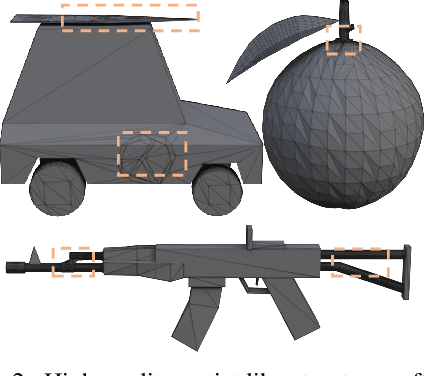
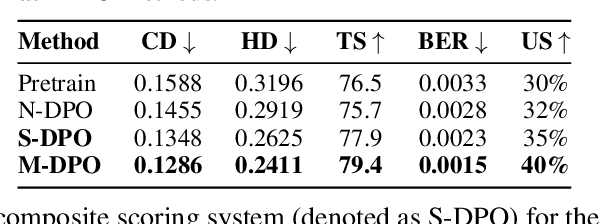
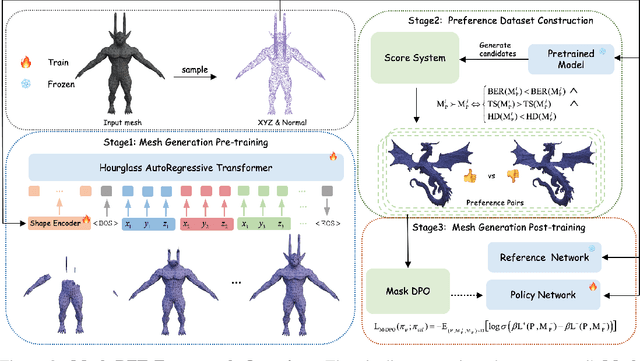
Abstract:Existing pretrained models for 3D mesh generation often suffer from data biases and produce low-quality results, while global reinforcement learning (RL) methods rely on object-level rewards that struggle to capture local structure details. To address these challenges, we present \textbf{Mesh-RFT}, a novel fine-grained reinforcement fine-tuning framework that employs Masked Direct Preference Optimization (M-DPO) to enable localized refinement via quality-aware face masking. To facilitate efficient quality evaluation, we introduce an objective topology-aware scoring system to evaluate geometric integrity and topological regularity at both object and face levels through two metrics: Boundary Edge Ratio (BER) and Topology Score (TS). By integrating these metrics into a fine-grained RL strategy, Mesh-RFT becomes the first method to optimize mesh quality at the granularity of individual faces, resolving localized errors while preserving global coherence. Experiment results show that our M-DPO approach reduces Hausdorff Distance (HD) by 24.6\% and improves Topology Score (TS) by 3.8\% over pre-trained models, while outperforming global DPO methods with a 17.4\% HD reduction and 4.9\% TS gain. These results demonstrate Mesh-RFT's ability to improve geometric integrity and topological regularity, achieving new state-of-the-art performance in production-ready mesh generation. Project Page: \href{https://hitcslj.github.io/mesh-rft/}{this https URL}.
FreeMesh: Boosting Mesh Generation with Coordinates Merging
May 19, 2025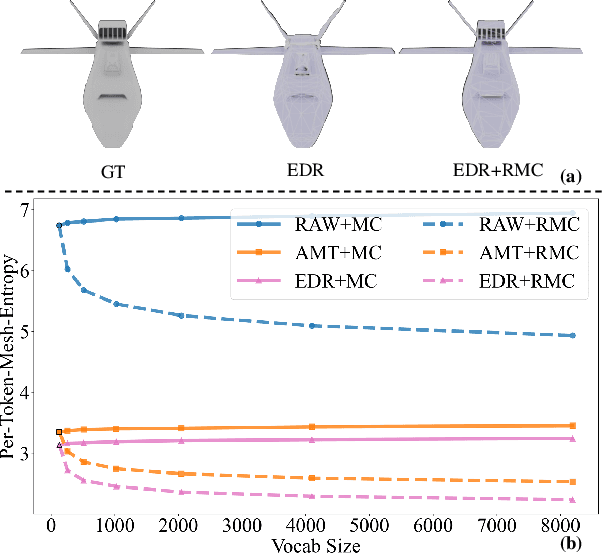
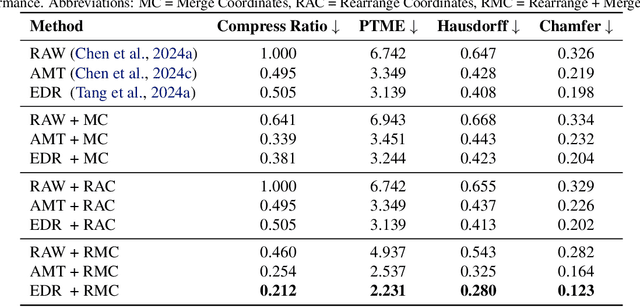
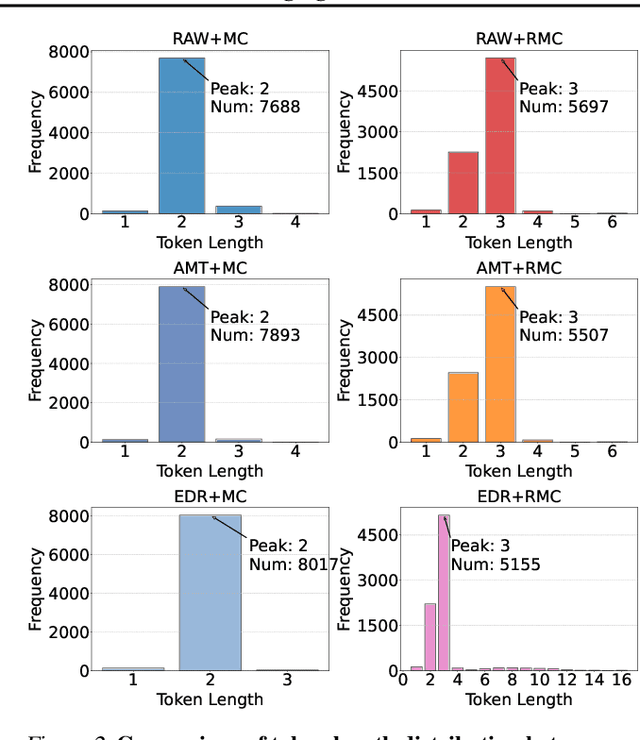

Abstract:The next-coordinate prediction paradigm has emerged as the de facto standard in current auto-regressive mesh generation methods. Despite their effectiveness, there is no efficient measurement for the various tokenizers that serialize meshes into sequences. In this paper, we introduce a new metric Per-Token-Mesh-Entropy (PTME) to evaluate the existing mesh tokenizers theoretically without any training. Building upon PTME, we propose a plug-and-play tokenization technique called coordinate merging. It further improves the compression ratios of existing tokenizers by rearranging and merging the most frequent patterns of coordinates. Through experiments on various tokenization methods like MeshXL, MeshAnything V2, and Edgerunner, we further validate the performance of our method. We hope that the proposed PTME and coordinate merging can enhance the existing mesh tokenizers and guide the further development of native mesh generation.
D$^{2}$MoE: Dual Routing and Dynamic Scheduling for Efficient On-Device MoE-based LLM Serving
Apr 17, 2025Abstract:The mixture of experts (MoE) model is a sparse variant of large language models (LLMs), designed to hold a better balance between intelligent capability and computational overhead. Despite its benefits, MoE is still too expensive to deploy on resource-constrained edge devices, especially with the demands of on-device inference services. Recent research efforts often apply model compression techniques, such as quantization, pruning and merging, to restrict MoE complexity. Unfortunately, due to their predefined static model optimization strategies, they cannot always achieve the desired quality-overhead trade-off when handling multiple requests, finally degrading the on-device quality of service. These limitations motivate us to propose the D$^2$MoE, an algorithm-system co-design framework that matches diverse task requirements by dynamically allocating the most proper bit-width to each expert. Specifically, inspired by the nested structure of matryoshka dolls, we propose the matryoshka weight quantization (MWQ) to progressively compress expert weights in a bit-nested manner and reduce the required runtime memory. On top of it, we further optimize the I/O-computation pipeline and design a heuristic scheduling algorithm following our hottest-expert-bit-first (HEBF) principle, which maximizes the expert parallelism between I/O and computation queue under constrained memory budgets, thus significantly reducing the idle temporal bubbles waiting for the experts to load. Evaluations on real edge devices show that D$^2$MoE improves the overall inference throughput by up to 1.39$\times$ and reduces the peak memory footprint by up to 53% over the latest on-device inference frameworks, while still preserving comparable serving accuracy as its INT8 counterparts.
BoxSeg: Quality-Aware and Peer-Assisted Learning for Box-supervised Instance Segmentation
Apr 07, 2025Abstract:Box-supervised instance segmentation methods aim to achieve instance segmentation with only box annotations. Recent methods have demonstrated the effectiveness of acquiring high-quality pseudo masks under the teacher-student framework. Building upon this foundation, we propose a BoxSeg framework involving two novel and general modules named the Quality-Aware Module (QAM) and the Peer-assisted Copy-paste (PC). The QAM obtains high-quality pseudo masks and better measures the mask quality to help reduce the effect of noisy masks, by leveraging the quality-aware multi-mask complementation mechanism. The PC imitates Peer-Assisted Learning to further improve the quality of the low-quality masks with the guidance of the obtained high-quality pseudo masks. Theoretical and experimental analyses demonstrate the proposed QAM and PC are effective. Extensive experimental results show the superiority of our BoxSeg over the state-of-the-art methods, and illustrate the QAM and PC can be applied to improve other models.
Orchestrating Joint Offloading and Scheduling for Low-Latency Edge SLAM
Feb 23, 2025Abstract:Visual Simultaneous Localization and Mapping (vSLAM) is a prevailing technology for many emerging robotic applications. Achieving real-time SLAM on mobile robotic systems with limited computational resources is challenging because the complexity of SLAM algorithms increases over time. This restriction can be lifted by offloading computations to edge servers, forming the emerging paradigm of edge-assisted SLAM. Nevertheless, the exogenous and stochastic input processes affect the dynamics of the edge-assisted SLAM system. Moreover, the requirements of clients on SLAM metrics change over time, exerting implicit and time-varying effects on the system. In this paper, we aim to push the limit beyond existing edge-assist SLAM by proposing a new architecture that can handle the input-driven processes and also satisfy clients' implicit and time-varying requirements. The key innovations of our work involve a regional feature prediction method for importance-aware local data processing, a configuration adaptation policy that integrates data compression/decompression and task offloading, and an input-dependent learning framework for task scheduling with constraint satisfaction. Extensive experiments prove that our architecture improves pose estimation accuracy and saves up to 47% of communication costs compared with a popular edge-assisted SLAM system, as well as effectively satisfies the clients' requirements.
 Add to Chrome
Add to Chrome Add to Firefox
Add to Firefox Add to Edge
Add to Edge